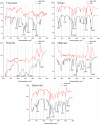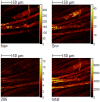Characterization of Natural Dyes and Traditional Korean Silk Fabric by Surface Analytical Techniques
- PMID: 28809257
- PMCID: PMC5452504
- DOI: 10.3390/ma6052007
Characterization of Natural Dyes and Traditional Korean Silk Fabric by Surface Analytical Techniques
Abstract
Time-of-flight secondary ion mass spectrometry (TOF-SIMS) and X-ray photoelectron spectroscopy (XPS) are well established surface techniques that provide both elemental and organic information from several monolayers of a sample surface, while also allowing depth profiling or image mapping to be carried out. The static TOF-SIMS with improved performances has expanded the application of TOF-SIMS to the study of a variety of organic, polymeric and biological materials. In this work, TOF-SIMS, XPS and Fourier Transform Infrared (FTIR) measurements were used to characterize commercial natural dyes and traditional silk fabric dyed with plant extracts dyes avoiding the time-consuming and destructive extraction procedures necessary for the spectrophotometric and chromatographic methods previously used. Silk textiles dyed with plant extracts were then analyzed for chemical and functional group identification of their dye components and mordants. TOF-SIMS spectra for the dyed silk fabric showed element ions from metallic mordants, specific fragment ions and molecular ions from plant-extracted dyes. The results of TOF-SIMS, XPS and FTIR are very useful as a reference database for comparison with data about traditional Korean silk fabric and to provide an understanding of traditional dyeing materials. Therefore, this study shows that surface techniques are useful for micro-destructive analysis of plant-extracted dyes and Korean dyed silk fabric.
Keywords: FTIR; TOF-SIMS; XPS; mordants; natural dyes; surface techniques; traditional silk fabric.
Figures











Similar articles
-
TOF-SIMS Analysis of Red Color Inks of Writing and Printing Tools on Questioned Documents.J Forensic Sci. 2016 May;61(3):815-22. doi: 10.1111/1556-4029.13047. Epub 2016 Feb 9. J Forensic Sci. 2016. PMID: 27122425
-
Surface chemical characterization of 2.5-microm particulates (PM2.5) from air pollution in Salt Lake City using TOF-SIMS, XPS, and FTIR.Environ Sci Technol. 2001 Aug 1;35(15):3113-21. doi: 10.1021/es0019530. Environ Sci Technol. 2001. PMID: 11505986
-
Identification of Natural Dyes in Ancient Textiles by Time-of-Flight Secondary Ion Mass Spectrometry and Surface-Enhanced Raman Spectroscopy.J Nanosci Nanotechnol. 2015 Nov;15(11):8701-5. doi: 10.1166/jnn.2015.11508. J Nanosci Nanotechnol. 2015. PMID: 26726579
-
Surface Characterization of Polymer Blends by XPS and ToF-SIMS.Materials (Basel). 2016 Aug 4;9(8):655. doi: 10.3390/ma9080655. Materials (Basel). 2016. PMID: 28773777 Free PMC article. Review.
-
Surface Sensitive Techniques for Advanced Characterization of Luminescent Materials.Materials (Basel). 2017 Aug 4;10(8):906. doi: 10.3390/ma10080906. Materials (Basel). 2017. PMID: 28777357 Free PMC article. Review.
Cited by
-
Time-of-Flight Secondary Ion Mass Spectrometry Coupled with Unsupervised Methods for Advanced Saffron Authenticity Screening.Foods. 2024 Jun 27;13(13):2033. doi: 10.3390/foods13132033. Foods. 2024. PMID: 38998539 Free PMC article.
-
Advanced materials for personal thermal and moisture management of health care workers wearing PPE.Mater Sci Eng R Rep. 2021 Oct;146:100639. doi: 10.1016/j.mser.2021.100639. Epub 2021 Aug 2. Mater Sci Eng R Rep. 2021. PMID: 34803231 Free PMC article. Review.
-
Mapping Natural Dyes in Archeological Textiles by Imaging Mass Spectrometry.Sci Rep. 2019 Feb 20;9(1):2331. doi: 10.1038/s41598-019-38706-4. Sci Rep. 2019. PMID: 30787311 Free PMC article.
-
Interactions between ZnO Nanoparticles and Polyphenols Affect Biological Responses.Nanomaterials (Basel). 2022 Sep 25;12(19):3337. doi: 10.3390/nano12193337. Nanomaterials (Basel). 2022. PMID: 36234465 Free PMC article.
-
Surface Analysis of Fermented Wheat and Rice Starch Used for Coating Traditional Korean Textiles.Materials (Basel). 2022 Mar 8;15(6):2001. doi: 10.3390/ma15062001. Materials (Basel). 2022. PMID: 35329454 Free PMC article.
References
-
- Degano I., Robechini E., Modugno F., Colombini M.P. Analytical methods for the characterization of organic dyes in artworks and in historical textiles. Appl. Spectrosc. Rev. 2009;44:363–410. doi: 10.1080/05704920902937876. - DOI
-
- Little S. Dye analysis helped to determine the treatment of two historically important textiles. Dyes Hist. Archaeol. 2005;20:80–88.
-
- Nowik W., Desrosiers S., Surowiec I., Trojanowicz M. The analysis of dyestuffs from first-to second-century textile artifacts found in the Martres-de-Veyre (France) excavations. Archaeometry. 2005;47:835–848. doi: 10.1111/j.1475-4754.2005.00235.x. - DOI
LinkOut - more resources
Full Text Sources
Other Literature Sources

